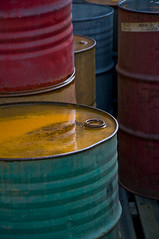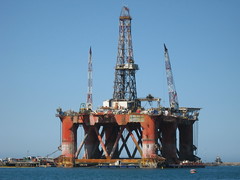- From the Houston Museum of Natural Science's blog- BEYONDbones-
On April 20, 2010 the Deepwater Horizon oil rig exploded in the Gulf of Mexico. Eleven people were lost and over 5,000 barrels of oil a day have been pumped into the gulf. It is a tragedy and one of the worst environmental disasters of all time.
This blog will help to explain why there is oil offshore, what an offshore oil rig is, what cementing and containment domes are and how we can help.
Crude oil is made form the desiccated remains of microscopic organisms that plied the water ways millions of years ago. They died (the very theme of nature), fell to the bottom of the ocean and were covered by layers of rock, sand and other debris. Through compression and temperature they were converted into hydrocarbons (crude oil and natural gas). Thanks to plate tectonics, many of these hydrocarbon reservoirs have ended up on land, but there are also many that are still under the ocean floor.
 |
The two countries that we import most of our oil from, Canada and Mexico, also have large offshore oil projects. Canada produces around 368 thousand barrels a day and Mexico produces 2.2 million barrels form their offshore wells. Other counties such as Saudi Arabia, Iran and Russia also have offshore production.
So what are offshore platforms? An offshore oil rig is like an extreme onshore rig. Not only does the rig have to drill thousands of feet through the earth, there is also have hundreds of feet of water on top of the drilling site. The rigs must also survive whatever the sea can toss at them, whether it be waves, hurricanes or tsunamis. There are many different types of offshore oil rigs. Deepwater Horizon was a semi-submersible rig, meaning that there were large tanks that would fill with water to submerse some of the oil rig, so that it would not move off the site it was drilling at. It can be put in water depth from 200 to 10,000 feet. A fixed platform is fixed in place by cement or steel legs and can go up to 1700 ft. A jacked up platform can use their legs to jack the platform up till it is above the water level, and then jack back down to move to a new location. They usually operate in up to 400 ft of water. A drillship is not a platform at all but a ship that can be used to drill wells. Its uses a series of thrusters to maintain position and it can operate in up to 13,000 feet of water.
 |
| Semi-submersible rig |
Cementing has come up a lot in the news recently. Most people may not know what that means. After a well is drilled and the casing is laid in, a special mixture of cement can be poured down to help support the well. It can help to keep the pressure constant, to reinforce the well walls or to plug up a well that is no longer producing. The cement used for the wells very from well to well. The mixture is based on the rock in the well and other variables such as the pressure at different depths.
If the pressure becomes too much an uncontrolled release can occur called a blowout. It can be oil, natural gas, water or a combination of two or three of those. One the most iconic examples of a blowout is Spindletop. No one wants a blow out. Not only does can it cause environmental damage but it can threaten the very lives of the people who work on rigs. To stop this there are automated measures and human control methods. For example, an operator could notice a change in pressure in the drilling mud. He would then try to relieve the pressure in a controlled method. If all else fails a blow out preventer can be used. A blow out preventer is a device that physically plugs the well so nothing can escape.
So if a blowout happens, then what? What happens when an offshore oil rig can’t stop producing such as Piper Alpha or Deepwater Horizon? Remote operated vehicles (ROVs) can be sent down to assess the situation and try to stanch the flow. A remotely operated vehicle is just that, a vehicle that is operated remotely by a person. If the ROVs can not stop the well a containment dome can be lowered down to cover the leak. A containment dome works by covering the area and then channeling the pressure off, and in this case to collect the crude oil. The first containment dome lowered down on the Deepwater Horizon was unsuccessful due to a build up of methane hydrates (or fire ice) on the dome. There are plans to drop a smaller dome, which would be easier to heat up if methane hydrates forms.
There are also efforts to contain and remove the oil that has come up. One of the choices is to burn off the crude oil. This can only be done under certain conditions, such as low winds, calm seas, and can not work on every spill. Another way is to put a boom around the spill to contain it and reclaim it. If the oil is on the surface, a skimmer can be used to gather and separate the oil. Chemicals can be sprayed on the oil spill to make the oil disperse or to clump together. Two types of dispersants have been spread on the Deepwater Horizon spill to help disperse it.
Another way to try and stop the oil that is coming out of the well is to drill a relief well. This would take the pressure off the well hole (it is like opening another hole in a shaken coke bottle to take the pressure off the main hole).
So what can we do? The national wildlife federation has created a page to help with that. Check with your barber or hair stylist to see if you can donate hair to make a boom. The best thing you can do is become energy aware. To understand where we get our energy from and how much of it you use. That is the first step to true energy independence.
Find this and more by visiting www.hmns.org


No comments:
Post a Comment